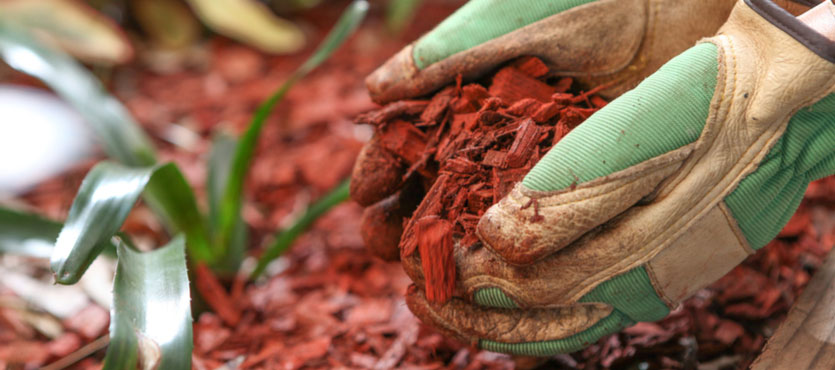Let’s talk mulch. Mulch can be made from a number of organic items – bark, wood, leaves, needles, grass – or inorganic items like pebbles, gravel, and even recycle tires. Mulch is used to cover soil, with the goal of presenting a beautiful aesthetically pleasing landscape as well as conserving water and helping to keep weeds away. And here in south Florida, mulch is a much need commodity.
Types of Mulch
As we explore mulch, let’s begin with the common types of mulch available, understanding that each type presents a variety of characteristics including color, origin, cost, nutrition, texture, appearance, and durability.
Knowing that, here are the more common types of mulch which you are most likely to encounter when making your selection:
- Leaves and Grass Clippings– Raked up from your yard at no cost, mulching with fallen leaves and grass clippings provides high levels of nutrients but must be replaced frequently as it decomposes quickly.
- Pine Needles (aka Pine Straw) – Like leaves, pine straw can be raked up for FREE from your yard if you have pine trees. If not, you can purchase pine straw in bundles. It comes from pine plantations where paper and wood are produced. As mulch, pine needles have longer staying power than leaves and grass clippings.
- Pine Bark Mulch – Like pine straw, pine bark mulch is an offshoot of the forestry industry. Offering a deep brown color, pine bark mulch comes in nugget form as well as ground.
- Hardwood Mulch – Made from trees to small for paper or wood production, that is then mixed with scrap lumber and recycled pallets, hardwood mulch is a popular and often less expensive option than other wood mulch products.
- Pebble or Gravel – While a long-lasting and attractive form of mulch, these stone mulch products won’t provide any nutrients to the soil or conserve water. When using pebbles or gravel, add a ground cloth to prevent sinkage into the south Florida sandy soil.
- Eucalyptus Mulch – Grown specifically for mulch, Eucalyptus Mulch is considered renewable because of the fast growth rate of the trees.
- Melaleuca Mulch – Made from invasive exotic trees, this mulch is cured to kill seeds and keep the trees from invading your garden.
Why Mulch?
As mentioned, mulch is applied to beautify, as well as deliver nutrients to your soil. In addition to aiding in water conservation (in most cases) mulch also protects the roots of your plants from extremes in temperature as well as keeping the soil moist and allowing the roots more time soak up the needed water. Mulch can also be used to manicure areas where plants and turf can’t survive. Not only does mulch help the plants, but it also adds nutrients to the soil as well, improving fertility, drainage ability, aeration, and reducing erosion.
How to Use Your Mulch Wisely
Apply a two to three-inch layer of mulch around trees, shrubs, and plants. Adding more can cause harm to your plants, not allowing water to reach the root systems. Don’t pile mulch against the bases of your trees. Doing so can hold moisture and cause the development of root rot or create a home for rodents who enjoy the tender mulch, bark, and will eventually kill your trees. When mulching around trees, mulch to the tree drip line, at least eight feet in diameter. Raking older mulch keeps it from becoming matting and prevent water from reaching plant roots, while also keeping your mulch looking good for longer periods of time.
Should you desire help selecting the best mulch for your landscaping or adding mulch to your landscape design, call the professionals at Xtreme Landscaping to help you created a beautiful, beneficial landscape design.

